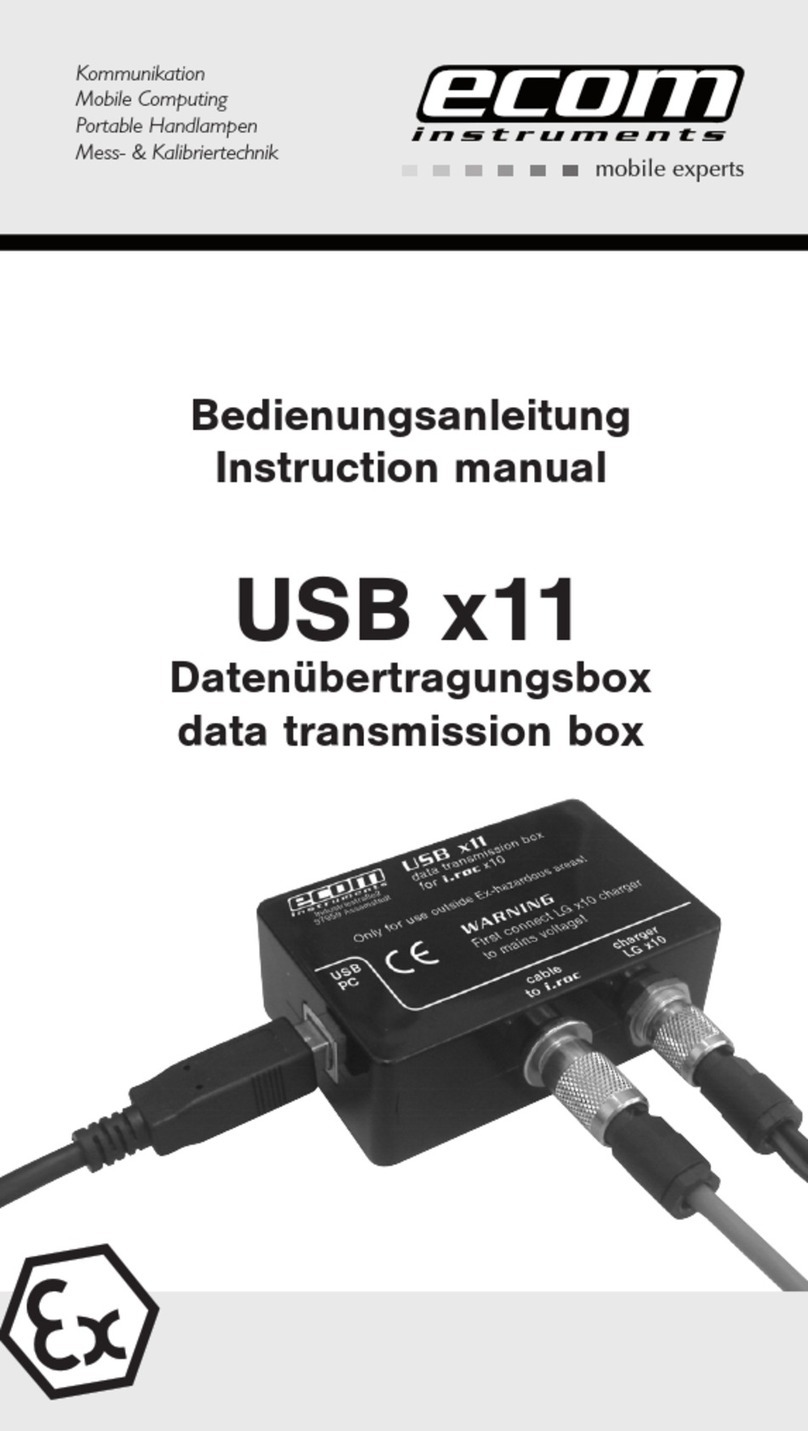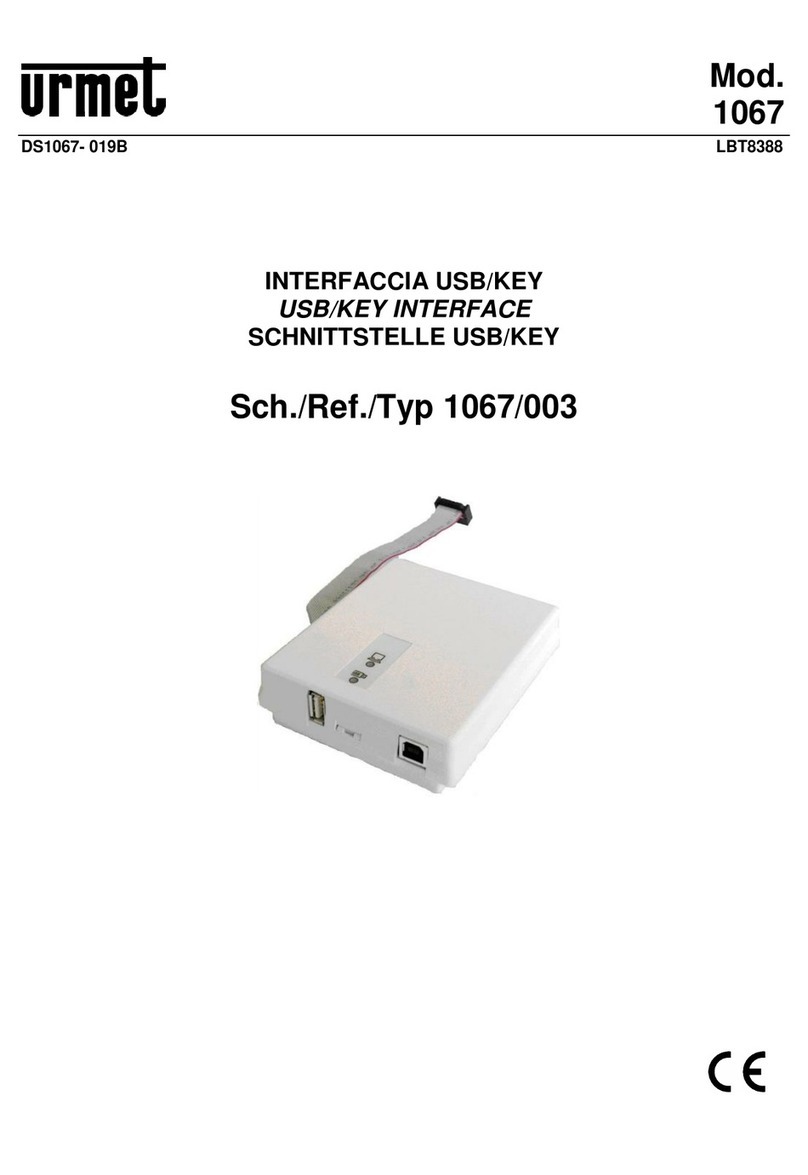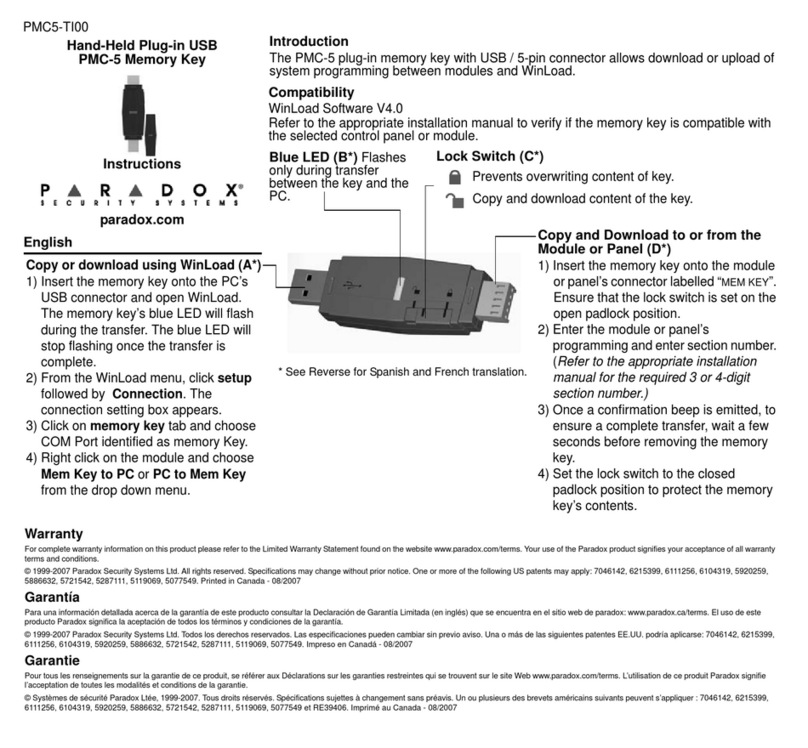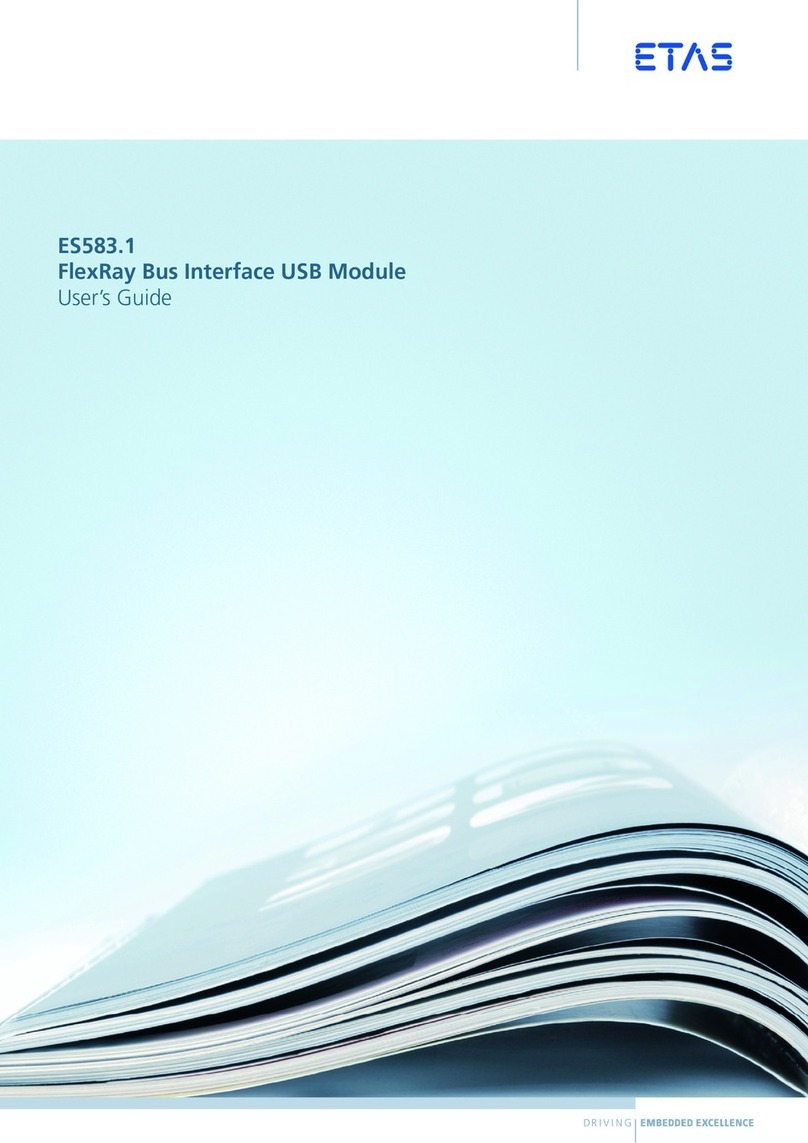Bluebell TDM-700 Series User manual

Operation Guide
TDM-700 Series
Fibre video interfaces
Ref: TDM-700 issue 1.2_01/14

TDM-700 Series Operation Guide V1.22
Bluebell Opticom Ltd.
Unit 2, The Quadrant
Howarth Road
Maidenhead
Berkshire
SL6 1AP
United Kingdom
Tel: +44 (0) 1628 510055
Fax: +44 (0) 1628 510057
Email: [email protected]
Web: www.bluebell.tv
Please note that all documentation herein is of a confidential nature and may not be reproduced without
written confirmation from Bluebell Opticom Ltd. The technical descriptions are to aid service and repair
only. Dissemination to a third party or parties will constitute breach of copyright.
Information in this document is subject to change without notice and does not represent a commitment
on the part of Bluebell Opticom Ltd.
Bluebell Opticom Ltd. has taken all possible steps to ensure that the information given here is both
correct and complete. In no event can Bluebell Opticom Ltd. accept any liability or responsibility for any
loss or damage to the owner of the equipment, any third party, or any equipment which may result from
use of this manual or the equipment which it describes.
Declaration of Conformities
The components of the Bluebell Opticom TDM-700 Fibre-optic Transmission System complies with the
essential requirements of the following EU directives, where appropriate:
89/336/EEC, EN61000-6-3, EN61000-6-4,EN55022B, EN61000-6-1, EN61000-6-2, EN61000-4-11,
EN61000-4-4 (Level 2), EN61000-4-4FTB, EN61000-4-2 and EN61000-4-5.
RoSH and WEEE declaration
Bluebell Opticom Ltd. complies with EU RoSH Directive 2002/95/EC, which restricts the use of
substances hazardous to humans and their environment in the manufacture of electrical and
electronic equipment.
The “crossed out wheelie bin” symbol on the enclosures and represented above is there to remind users
of the obligation of selective collection of waste. This label is applied to various products to indicate
that the product is not to be thrown away as unsorted municipal waste. At the end of life, dispose of
this product by returning it to the point of sale or to your local municipal collection point for recycling of
electric and electronic devices.
Customer participation is important to minimize the potential effects on the environment and human
health that can result from hazardous substances that may be contained in this product.
Please dispose of this product and its packaging in accordance with local and national disposal
regulations, including those governing the recovery and recycling of waste electrical and electronic
equipment. Contact your local waste administration, waste collection company or dealer.

TDM-700 Series Operation Guide V1.2 3
Table of Contents
Declaration of Conformities.................................................2
RoSH and WEEE declaration ................................................2
Overview.................................................................4
Introduction..........................................................................4
Variants..............................................................................4
Power requirements .................................................................6
TDM-700 Series connections ...............................................7
System block diagrams ....................................................9
Connections for Installation................................................10
Base end ...........................................................................10
Camera end ........................................................................12
Appendix................................................................13
Specifications – TDM-700 System.................................................13
Optical wavelengths................................................................14

TDM-700 Series Operation Guide V1.24
Overview
Thank you for purchasing this Bluebell Opticom professional broadcast video product. If you are new to
Bluebell products, or to the subject of transmitting video and/or other data over fibre links, please take
the time to read through this document before putting the TDM-700 to use.
Introduction
The TDM-700 Series is a range of compact and rugged fibre interfaces designed specifically for
Outside Broadcast (OB) applications. They allow the implementation of a dual-fibre optical link between
a remote POV (Point of View) Camera and an OB van (or Control Room).
With all TDM-700 Series models, the optical link carries an HD/SD-SDI feed from the camera. Certain
TDM-700 variants can additionally:
• Add a return composite video feed for genlock or monitoring.
• Add bi-directional RS-232/RS-422 data and a GPI tally to the multiplex, allowing full remote
control of the POV.
• Add a 10/100 BaseT Ethernet link to the multiplex, allowing control of IP-based devices.
A single TDM-700 link requires two interfaces; one is installed at the POV Camera location, the other in
the OB van/Control Room.All interfaces are fitted with a dual optical port, separate fibres being used for
data in each direction.
Variants
Multiplex options
Four versions of the TDM-700 range are available; these differ in the types of additional information
which can be encoded along with an HD-SDI video signal (common to all versions).
• TDM-700: HD-SDI video plus Ethernet, RS-232/422 serial/GPI and genlock
• TDM-710: HD-SDI video plus genlock and RS-232/422 serial/GPI
• TDM-720: HD-SDI video plus RS-232/422 serial/GPI only
• TDM-730: HD-SDI video plus Ethernet only
Physical formats
TDM-700 Series interfaces are available in two formats: plug-in cards or stand-alone units. Some
versions can be supplied in either format.
Plug-in cards:
These are designed to fit the Bluebell BC-100 or BC-160 19” modular rack enclosures. The racks
can house six (BC-160) or fifteen (BC-100) interface cards, and are fitted with dual internal AC power
supplies. (The racks are also compatible with Bluebell BC Series interface cards.)
Alternatively, cards may be fitted into smaller aluminium chassis; the BC101 and BC102 hold one and
two cards respectively and require an external DC power source, while the BC120 holds three cards and
has an integral mains PSU.

TDM-700 Series Operation Guide V1.2 5
All plug-in cards are fitted with cartridge-style SFP dual fibre transceiver modules. The transmitter
wavelength is specified at the time of order, but cartridges may be changed in the field at a later date if
necessary. The receivers are wideband. See page 14 for more details of optical wavelengths.
Extended stand-alone units:
The TDM-700 and TDM-710 are available as ‘stand-alone’ units; these versions have type numbers
ending with the suffix ‘E’.
The stand-alone units consist of one interface card in a fully-enclosed robust aluminium casing, and are
intended for remote location in a (possibly) hostile OB environment. They require an external DC power
source; a suitable AC mains adaptor is supplied with each unit.
Stand-alone units utilise a heavy-duty fibre connector suitable for outdoor use and field deployment.
Two types of connector are available – Lemo L3K or Neutrik OpticalCON – the type is specified at the
time of order. The transmitter wavelength is generally fixed at 1310 nm (alternatives may be supplied to
special order) and the receivers are wideband.
Base and Camera ends
All TDM-700 versions are available for installation either at the “base station” end of the fibre connection
(type numbers with suffix ‘B’) or at the “camera” end (type numbers with suffix ‘C’). Base interfaces
encode genlock, serial/GPI control data and Ethernet data for transmission to the remote location
and extract HD-SDI video from the received fibre bitstream. Camera interfaces perform the opposite
functions, receiving and decoding control data while encoding the camera video signal for transmission
back to base.
The various options are summarised in the following table. This User Guide is applicable to all models
listed below.
Location Multiplex of:
Base Camera HD-SDI Genlock Serial/GPI Ethernet
Plug-in cards:
TDM-700B ✓ ✓ ✓ ✓ ✓
TDM-700C ✓ ✓ ✓ ✓ ✓
TDM-710B ✓ ✓ ✓ ✓
TDM-710C ✓ ✓ ✓ ✓
TDM-720B ✓✓✓
TDM-720C ✓ ✓ ✓
TDM-730B ✓ ✓ ✓
TDM-730C ✓ ✓ ✓
Stand-alone units:
TDM-700BE ✓ ✓✓✓✓
TDM-700CE ✓ ✓ ✓ ✓ ✓
TDM-710BE ✓ ✓ ✓ ✓
TDM-710CE ✓ ✓ ✓ ✓

TDM-700 Series Operation Guide V1.26
Power requirements
For all versions, power supply requirements are dictated by the enclosure type used.
BC-100 modular rack units:
These may be fitted with either one or two AC mains PSU modules (number specified at time of order).
Each module has sufficient capacity to power a fully-loaded rack. The AC connection is via standard
IEC cables, DC power distribution inside the rack is via the motherboard. See the User Guide supplied
with the rack units for more details.
BC-160 modular rack units:
These are fitted as standard with dual internal AC mains power supplies of sufficient capacity to power
a fully-loaded rack. TheAC connection is via standard IEC cables, DC power distribution inside the rack
is via the motherboard. See the User Guide supplied with the rack units for more details.
BC101 and BC102 single- and dual-slot chassis:
These are supplied with an external UniversalAC adaptor which connects to the chassis via a flying lead
terminated in a 4-pin locking XLR connector. Mains is via an IEC connector.
BC120 triple-slot chassis:
This housing for three plug-in cards is fitted with an internal AC mains supply; mains connection is via a
rear IEC connector.
TDM-7xxBE/CE Stand-alone versions:
The Stand-alone enclosures are fitted with a 4-pin XLR male connector. They are supplied with an
external Universal AC adaptor with a flying lead terminated in a mating XLR. AC mains to the adaptor is
via a standard IEC connector.
TDM-700C TDM-700CE
(with LEMO connector)

TDM-700 Series Operation Guide V1.2 7
TDM-700 Series connections
Plug-in cards:
TDM-700B
HD-SDI OPTICAL I/O ETHERNET
TDM-700C
HD-SDI OPTICAL I/O ETHERNET
GENLOCK
GENLOCK
DATA I/O
DATA I/O
TDM-710B
HD-SDI OPTICAL I/O
TDM-710C
HD-SDI OPTICAL I/O
GENLOCK
GENLOCK
DATA I/O
DATA I/O
TDM-720B
HD-SDI OPTICAL I/O
TDM-720C
HD-SDI OPTICAL I/O
DATA I/O
DATA I/O
TDM-730B
HD-SDI OPTICAL I/O ETHERNET
TDM-730C
HD-SDI OPTICAL I/O ETHERNET
1310 nm
7
2
8
9
10
3
1
4
5
6
Stand-alone units:
HD-SDI ETHERNET
GENLOCK DATA I/O
61 54
8 7 9 10
Optical I/O12V DC
1112
1. HD-SDI – 75 ohm BNC connector for input (camera end) or output (base end) of HD SDI video. See
page 13 for standards supported.
2. OPTICAL I/O – SFP dual fibre connector. The connector is mounted on a removable cartridge.
3. Transmission wavelength – a sticker will be fitted to the faceplate to indicate the wavelength (in nm)
of the optical transmitter, If no sticker is fitted, the wavelength can be taken as 1310 nm.
4. GENLOCK – 75 ohm BNC connector for input (base end) or output (camera end) of standard 1 V
pk-pk genlock signal. Compatible with Black Burst and Tri-level sync standards. This connection
can be used to distribute genlock to the POV locations, or to send a return video feed to the POV for
monitoring purposes.
5. ETHERNET – standard RJ45 network connector. 10/100 MB/s half-/full-duplex, with auto-negotiation.
Use this connection to interface with POV cameras equipped with Ethernet control, or if an Ethernet
link to the POV location is required for any other purpose. The connector has integral LEDs to confirm
a valid link (green) and data activity (yellow).

TDM-700 Series Operation Guide V1.28
6. DATA I/O – 9-pin female Dsub connector for RS-232/422 bi-directional data transmission. Two GPI
control/tally lines are included. Note that as this connector is multi-functional, the pinout is non-
standard:
PIN FUNCTION
1 GND
2 RS-232 O/P
3 RS-422 I/P +
4 GPI OUT
5 RS-422 O/P -
6 RS-232 I/P
7 GPI IN
8 RS-422 I/P -
9 RS-422 O/P +
7. Video valid LED – illuminates when a valid SDI video signal is present at the HD-SDI BNC connector.
On camera end cards (‘C’ suffix) this confirms a good video feed from the camera itself. On base end
cards (‘B’ suffix), it confirms that a good video signal has been recovered from the optical data.
8. Optical activity LED – illuminates when valid optical data is received at the fibre port.
9. Serial data activity (input) LED – illuminates when RS-232/422 data is present at the serial inputs of
the Dsub connector.
10.Serial data activity (output) LED – illuminates when RS-232/422 data is present at the serial outputs
of the Dsub connector.
11.OPTICAL I/O – The TDM-700 Series BE and CE versions are fitted with either a Lemo L3K or a
Neutrik OpticalCON dual fibre connector.
12.DC INPUT – 4-pin latching male XLR connector for DC power input from the externalAC adaptor. The
pinout is as follows:
PIN FUNCTION
10 V
2 n/c
3 n/c
4 DC IN (4.5 – 17 V)

TDM-700 Series Operation Guide V1.2 9
System block diagrams
HD/SD Optical Output
M
U
X
/
D
E
M
U
X
Optical Driver/
Limiting Amplifier
RS422
RS232
Genlock
Optical Input
PIN TIA/
Limiting Amplifier
GPI/Tally
Line Eq
10/100BaseT
HD/SD
Optical Output
M
U
X
/
D
E
M
U
X
Optical Driver/
Limiting Amplifier
RS422
RS232
Genlock
Optical Input
PIN TIA/
Limiting Amplifier
10/100BaseT
GPI/Tally
HD/SD Optical Output
M
U
X
/
D
E
M
U
X
Optical Driver/
Limiting Amplifier
RS422
RS232
Genlock
Optical Input
PIN TIA/
Limiting Amplifier
GPI/Tally
Line Eq HD/SD
Optical Output
M
U
X
/
D
E
M
U
X
Optical Driver/
Limiting Amplifier
RS422
RS232
Genlock
Optical Input
PIN TIA/
Limiting Amplifier
GPI/Tally
HD/SD Optical Output
M
U
X
/
D
E
M
U
X
Optical Driver/
Limiting Amplifier
RS422
RS232
Optical Input
PIN TIA/
Limiting Amplifier
GPI/Tally
Line Eq HD/SD
Optical Output
M
U
X
/
D
E
M
U
X
Optical Driver/
Limiting Amplifier
RS422
RS232
Optical Input
PIN TIA/
Limiting Amplifier
GPI/Tally
HD/SD Optical Output
M
U
X
/
D
E
M
U
X
Optical Driver/
Limiting Amplifier
Optical Input
PIN TIA/
Limiting Amplifier
Line Eq
10/100BaseT
HD/SD
Optical Output
M
U
X
/
D
E
M
U
X
Optical Driver/
Limiting Amplifier
Optical Input
PIN TIA/
Limiting Amplifier
10/100BaseT
The TDM-700 system uses two 3G optical signals on twin fibres to provide a robust long-distance
interconnection between camera and base station. The interconnection can carry a multiplex of
HD-SD/SDI video, genlock, RS-232/422 serial and/or Ethernet control signals, plus a bi-directional GPI
command/tally.
To allow a remote camera to be synchronised to the station genlock reference, the genlock must be
transported across the TDM-700 link. The TDM-700B base unit combines the genlock with any GPI and
control data onto a 3G optical carrier, which is sent through the fibre to the TDM-700C camera end unit.
The genlock and control data are extracted from the optical bitstream and fed to the camera.
TDM-700C TDM-700B
TDM-710C TDM-710B
TDM-720C TDM-720B
TDM-730C TDM-730B
CameraCameraCameraCamera

TDM-700 Series Operation Guide V1.210
The camera’s synchronised HD/SD-SDI video output is fed into the TDM-700C interface, together with
any return control data. The TDM-700C encodes them onto another 3G optical carrier for transmission
back to the base station using the second fibre. The TDM-700C card normally synchronises to the SDI
signal; if there is no camera output for any reason, it free-runs. The returned optical signal is received at
the base station, which synchronises to the incoming 3G data, thus ensuring that the extracted SDI feed
remains in sync with the original genlock.
All common SDI standards and line/frame rates are supported and auto-detected (see page 13), and
the system will assume the standard of the video signal applied at the camera end. If no SDI signal is
present on initial power-up, the TDM-700 defaults to 1080i/50. The video recovered at the base station
will always be of the same standard as that encoded at the camera end. In the event of loss of video, the
last-used standard will be stored as long as power is applied.
Connections for Installation
The TDM-700 system has been designed for rapid deployment; no set-up procedure is necessary.
Base end:
TDM-700B, TDM-710B, TDM-720B and TDM-730B: plug the card into a spare slot in a Bluebell BC100,
BC160 modular rack unit or a BC120 triple-slot enclosure. Power is provided by the rack in these cases.
If using a BC101 or BC102 enclosure, fit the card and connect an external source of DC power via the
XLR4 socket. TDM-700BE stand-alone units are self-contained and merely require external DC power
to be connected,
Input Connections:
• Genlock (TDM-700B, TDM-710B and TDM-710BE): this can be a standard Bi-level (Black Burst) or
Tri-level sync. The peak-to-peak input level must not exceed 1.8 V. Alternatively, the input can be
used as a monitoring feed back to the POV.
Output connections:
• Video (all versions): HD/SD-SDI output from the camera.
Bi-directional connections:
• Optical – on all plug-in card versions the optical port is a dual SFP port on a removable transceiver
cartridge. Use single-mode fibres to connect either directly to the POV location, or to a break-
out panel to convert to ruggedised fibre for outside deployment. The transmission wavelength is
1310 nm, unless the faceplate is marked to the contrary.
Onstand-alone(BE)versions,theopticalconnectorwillbeeitheraLemoL3Kor aNeutrikOpticalCOM
(specified at time of ordering).
• Ethernet (TDM-700B, TDM-720B and TDM-700BE): This passes Ethernet data transparently to/from
the POV device. The TDM-700 system does not appear to a network as a client. Use this connection
with a POV camera (or other device) which can be controlled via Ethernet. The port auto-negotiates
full or half duplex 10/100 BaseT working.
• Serial/GPI (TDM-700B, TDM-710B, TDM-730B and TDM-700BE): see the pinout table at
page 8 for wiring details. Use this connection with cameras requiring RS-232/422 serial control.
Connect pins 1, 2 and 6 if using RS-232, or pins 1, 3, 5, 8 and 9 if using RS-422; maximum data rates
are approximately 120 kbaud for RS-232 and 1 Mbaud for RS-422.

TDM-700 Series Operation Guide V1.2 11
Note that when using the TDM-700 system with camera control systems using RS-232 and RS-422,
“crossed” cables are needed at both the base and camera ends. The diagram below shows the
required interconnections:
Fibre
TDM-700B TDM-700C
CAMERA
RS-422 Tx
RS-422 Rx
RS-422 Tx
RS-422 Rx
D-Type D-Type
9,5
3,8
9,5
3,8
Connections for RS-422 camera control
BASE - RCP
(Remote Control Panel)
Fibre
TDM-700B TDM-700C
CAMERA
BASE - RCP
(Remote Control Panel)
RS-232 Tx
RS-232 Rx
RS-232 Tx
RS-232 Rx
D-Type D-Type
2
6
2
6
Connections for RS-232 camera control
Pins 7 and 4 are reserved for a general purpose DC control command and a corresponding tally
output respectively. Both are active LOW; the input has an internal pull-up resistor to 3.3 V. The output
is diode-protected, and should be used with an external pull-up resistor; the pull-up voltage should be
less than 5.5 V and the current drawn not more than 24 mA.
The command and tally lines can be used for any general signalisation purpose.

TDM-700 Series Operation Guide V1.212
Camera end:
TDM-700C, TDM-710C, TDM-720C and TDM-730C: plug the card into a spare slot in a Bluebell BC100,
BC160 modular rack unit or a BC120 triple-slot enclosure. Power is provided by the rack in these cases.
If using a BC101 or BC102 enclosure, fit the card and connect an external source of DC power via the
XLR4 socket. TDM-700CE stand-alone units are self-contained and merely require external DC power
to be connected,
Input Connections:
• Video (all versions): connect the camera’s HD/SD-SDI output to this BNC socket.
Output connections:
• Genlock (TDM-700C, TDM-710C and TDM-710CE): this carries the genlock (or monitoring video)
signal connected at the GENLOCK input at the base end.
Bi-directional connections:
• Optical – on all plug-in card versions the optical port is a dual SFP port on a removable transceiver
cartridge. Use single-mode fibres to connect either directly to the base end, or to a break-out panel
to convert to ruggedised fibre. As at the base end, the transmission wavelength is 1310 nm, unless
the faceplate is marked to the contrary.
Onstand-alone(CE)versions,theopticalconnectorwillbe eitheraLemo L3Kora NeutrikOpticalCON
(specified at time of ordering).
• Ethernet (TDM-700C, TDM-720C and TDM-700CE): This passes Ethernet data transparently to/
from the base location. Use Cat 5 cable to connect to an Ethernet-controllable camera (or other
device).
• Serial/GPI (TDM-700C, TDM-710C, TDM-730C and TDM-700CE): see the pinout table at page 8
for wiring details. Use this connection with cameras requiring RS-232/422 serial control.
Pins 7 and 4 should be connected if the GPI command and/or tally lines are to be used.

TDM-700 Series Operation Guide V1.2 13
Appendix
Specifications – TDM-700 System
HD/SD video input from camera
Connector 75 ohm BNC per IEC 60169-8 Amendment 2
Standards supported SMPTE 292M, SMPTE 259M, SMPTE 297M
Line/frame rates (625/50, 525/59.94,1080i/50, 1080i/59.94, 720p/50,
720p/59.94 – auto detecting)
Equalisation Automatic to 200 m @ 1.485 Gb/s
Automatic to 300 m @ 270 Mb/s
Return Loss >15 dB @ 1.485 Gb/s
HD/SD video output from base unit
Connector 75 ohm BNC per IEC 60169-8 Amendment 2
Return Loss >15 dB @ 1.485 Gb/s
Polarity Non-inverting
Signal Level 800 mV +/- 10%
Jitter 0 ±0.5 V
Genlock Video Input and Output
Standards Composite 1 V pk-pk; PAL, NTSC, SECAM; Bi-Level, Tri-
Level syncs
Connector 75 ohm BNC
Diff Phase < 1°
Diff Gain < 1% (at sub-carrier 3.58/4.43 MHz)
Ethernet Input/Output
Connector RJ45
Format Full duplex 100Base-FX Data Transmission with 1/100 MB/s
half/full duplex auto-negotiation
Data Input/Output
Connector 9-pin female Dsub
Format 1 x RS-232, 1 x RS-422 , 1 x GPI, all bi-directional
RS-232 I/P Level VIL < 0.6 V, VIH > 2.4 V
RS-232 O/P Level ± 5.4 V typical
General plug-in card specifications
Depth 60 mm
Width 20 mm 4TE
Height 100 mm (3RU)
Weight 100 g
Operating Temp -30 to +70°C
Power 6 W
General stand-alone unit specifications (Exact size is connector-dependant)
Depth 160 mm
Width 120 mm
Height 45 mm
Weight 200 g

TDM-700 Series Operation Guide V1.214
Conformities
EMI/RFI Complies with 89/336/EEC
Electrical Complies with EN 61000-6-1, EN61000-6-2
Laser Safety Complies with Class 1 laser product 24 CFR 1040.10 &
1040.11
RoHS Complies with Directive 2002/95/EC
Optical Input/Output
Physical SFP Transceiver Module
Connector Plug-in cards: SFP; Stand-alone units: Lemo L3K or Neutrik
OptiCOM
Wavelength Plug-in cards: CWDM wavelengths (see table below)
Stand-alone units: 1310 nm single mode or 850 nm multi
mode (or user-specified)
Optical Power -2 dBm @ 1310/1510 nm (typical)
Optical wavelengths
TDM-700 Series plug-in cards are fitted with a removable SFP transceiver cartridge. These have a
standard transmission wavelength of 1310 nm, however the wavelength may be specified at the time
of ordering to be any of the standard CWDM wavelengths. Cartridges are field-interchangeable. All
receivers are wideband.
Part Ref. Transmitter Receiver
Standard wavelengths:
VTR/S/SFP Single mode, dual channel SFP transceiver, 1310 nm Wideband
VTR/M/SFP Multi mode, dual channel SFP transceiver, 850 nm
CWDM wavelengths:
VTR/S/SFP/CWDM/27 Single mode, single channel CWDM SFP transmitter, 1270nm
Wideband
VTR/S/SFP/CWDM/29 Single mode, single channel CWDM SFP transmitter, 1290nm
VTR/S/SFP/CWDM/31 Single mode, single channel CWDM SFP transmitter, 1310nm
VTR/S/SFP/CWDM/33 Single mode, single channel CWDM SFP transmitter, 1330nm
VTR/S/SFP/CWDM/35 Single mode, single channel CWDM SFP transmitter, 1350nm
VTR/S/SFP/CWDM/37 Single mode, single channel CWDM SFP transmitter, 1370nm
VTR/S/SFP/CWDM/39 Single mode, single channel CWDM SFP transmitter, 1390nm
VTR/S/SFP/CWDM/41 Single mode, single channel CWDM SFP transmitter, 1410nm
VTR/S/SFP/CWDM/47 Single mode, single channel CWDM SFP transmitter, 1470nm
VTR/S/SFP/CWDM/49 Single mode, single channel CWDM SFP transmitter, 1490nm
VTR/S/SFP/CWDM/51 Single mode, single channel CWDM SFP transmitter, 1510nm
VTR/S/SFP/CWDM/53 Single mode, single channel CWDM SFP transmitter, 1530nm
VTR/S/SFP/CWDM/55 Single mode, single channel CWDM SFP transmitter, 1550nm
VTR/S/SFP/CWDM/57 Single mode, single channel CWDM SFP transmitter, 1570nm
VTR/S/SFP/CWDM/59 Single mode, single channel CWDM SFP transmitter, 1590nm
VTR/S/SFP/CWDM/61 Single mode, single channel CWDM SFP transmitter, 1610nm

TDM-700 Series Operation Guide V1.2 15
This manual suits for next models
15
Table of contents



